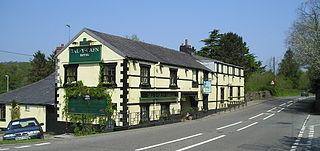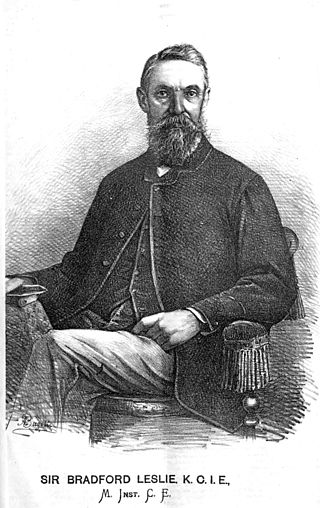Related Research Articles

Herefordshire is a ceremonial county in the West Midlands of England. It is bordered by Gloucestershire to the south-east, Worcestershire to the east, Shropshire to the north and the Welsh counties of Monmouthshire and Powys to the west. The city of Hereford is the largest settlement and the county town.

Joseph Baermann Strauss was an American structural engineer who revolutionized the design of bascule bridges. He was the chief engineer of the Golden Gate Bridge in San Francisco, California.

The Lethbridge Viaduct, commonly known as the High Level Bridge, is a railway trestle bridge over the Oldman River in Lethbridge, Alberta, Canada. Constructed between 1907 and 1909 by the Canadian Pacific Railway, it is the largest railway structure in Canada and the largest of its type in the world, and is still regularly maintained and used over a century since its construction.

The Crystal Palace transmitting station, officially known as Arqiva Crystal Palace, is a broadcasting and telecommunications site in the Crystal Palace area of the London Borough of Bromley, England. It is located on the site of the former television station and transmitter operated by John Logie Baird from 1933.

A transmission tower is a tall structure, usually a lattice tower made of steel that is used to support an overhead power line. In electrical grids, transmission towers carry high-voltage transmission lines that transport bulk electric power from generating stations to electrical substations, from which electricity is delivered to end consumers; moreover, utility poles are used to support lower-voltage sub-transmission and distribution lines that transport electricity from substations to electricity customers.

Tal-y-Cafn railway station is located at Tal-y-Cafn, Wales, on the Conwy Valley Line from Llandudno Junction to Blaenau Ffestiniog.
The Bellman Hangar was designed in the United Kingdom in 1936 by the Directorate of Works structural engineer, N. S. Bellman, as a temporary aircraft hangar capable of being erected or dismantled by unskilled labour with simple equipment and to be easily transportable. Commercial manufacturing rights were acquired by Head Wrightson & Co of Teesdale Iron Works, Thornaby-on-Tees. By November 1938, 10 had even been supplied to Russia.

Tal-y-Cafn is a small settlement in Conwy county borough, north Wales, in the community of Eglwysbach.

The Jubilee Bridge is a former rail bridge over the Hooghly River between Naihati and Bandel in West Bengal, India. It provided an important connection between Garifa railway station and Hooghly Ghat railway station.
Located on the Mississippi River, the metropolitan area of Memphis is one of the largest in the Southeastern United States, ranking 42nd in the United States according to the 2010 census. The city has historically been one of the largest shipping hubs in the Mid-South, dating back to the Civil War, when the port was one of the largest on the Mississippi River and served as a shipping hub for the Confederacy.
Railway stations in Uganda include:

The Callender-Hamilton bridge is a modular portable pre-fabricated truss bridge. It is primarily designed for use as permanent civil bridging as well as for emergency bridge replacement and for construction by military engineering units. Assembling a Callender-Hamilton bridge takes much longer than the more familiar Bailey bridge as it is made up of individual lengths of galvanised steel bolted together with galvanised high-strength steel bolts, all of which require torque settings. It is stronger and simpler in design concept than the Bailey bridge.

Sir Bradford Leslie KCIE (1831-1926) was an English civil engineer who specialised in bridges and was a pupil of Isambard Kingdom Brunel. His most notable achievement was the 1887 Jubilee Bridge.

The Goteik viaduct also known as Gohteik viaduct) is a railway trestle over the Goteik Gorge of the Myitnge River in western Shan State, Myanmar. The bridge is between the two towns of Nawnghkio and Gokhteik, and it's part of the railways between Pyin Oo Lwin, the summer capital of the former British colonial administrators of Burma, and Lashio, the principal town of northern Shan State. It is the highest bridge in Myanmar and when it was completed, the largest railway trestle in the world. It is located approximately 100 km northeast of Mandalay.

U.S. Highway 136 (US 136) is a short U.S. Highway in Keokuk, Iowa. The route was designated nationally in 1951 and has remained largely unchanged through Keokuk since then. The highway originally crossed the Mississippi on the Keokuk Rail Bridge, which was the second bridge built and operated by Andrew Carnegie's Keokuk & Hamilton Bridge Company in that location. While it was designed for wagons and early automobiles, crossing the rail bridge became difficult in larger modern vehicles, specifically semi trucks. As a result, a new automobile-only bridge was built directly to the south of the older span. The Keokuk–Hamilton Bridge opened in 1985 eight months early and under budget.

The Cheshire Bridge spans the Connecticut River between Charlestown, New Hampshire and Springfield, Vermont.
Kyaka Bridge, sometimes referred to as the Kagera Bridge, is a bridge in Tanzania that crosses the Kagera River. The bridge was blown up by Ugandan experts from Kilembe Mines in 1978 during the Uganda–Tanzania War.

The Brazeau Bottom is an alluvial floodplain, also called a 'flat', extending along the Mississippi River in Perry County, Missouri.
References
- ↑ http://www.gracesguide.co.uk/wiki/Painter_Brothers GRACE'S GUIDE
- ↑ "PAINTER BROTHERS LIMITED, HR4 9SW : Companies House Number 00238081".
- ↑ http://www.flightglobal.com/pdfarchive/view/1938/1938%20-%200196.html FLIGHT, JANUARY 20, 1938
- ↑ http://www.britishpathe.com/record.php?id=33317 EXHIBITION SITE READY FOR OPENING – British Pathé
- ↑ "About us".
- ↑ "Painter Brothers - the Kyaka River Bridge in Tanzania". Archived from the original on 2012-03-24. Retrieved 2011-05-17.
- ↑ https://www.flickr.com/photos/marcell_claassen/4668655005/ [ dead link ]
- ↑ "Painter Brothers - The Chum Phon Rail Bridge in Thailand". www.painterbrothers.com. Archived from the original on 2006-03-11.
- ↑ "Painter Brothers - Crystal Palace Tower in London". www.painterbrothers.com. Archived from the original on 2006-03-11.
- ↑ "Painter Brothers - The Gorai River Bridge in Banagladesh". www.painterbrothers.com. Archived from the original on 2006-03-11.
- ↑ "Painter Brothers - Tal-y-Cafn Bridge in North Wales". Archived from the original on 2012-03-24. Retrieved 2011-05-15.
- ↑ "Painter Brothers - Tekeze Bridge in Ethiopia". www.painterbrothers.com. Archived from the original on 2006-03-11.